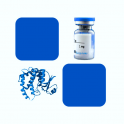
- Remove this product from my favorite's list.
- Add this product to my list of favorites.
Products
Newsletter
 |  |  |  |  |  |

Background
Coxsackie virus and adenovirus receptor (CXADR) also known as CAR, is a type I transmembrane glycoprotein for group B coxsackie viruses and subgroup C adenoviruses, and belongs to the CTX family of the Ig superfamily. CAR is strongly expressed in the developing central nervous system. It functions as a homophilic and also as a heterophilic cell adhesion molecule through its interactions with extracellular matrix glycoproteins such as: fibronectin, agrin, laminin-1 and tenascin-R. Human CXADR protein contains a signal sequence, a extracellular domain (ECD) with a V type (D1) and a C2 type (D2) Iglike domain, a transmembrane segment and a intracellular domain. D1 is thought to be responsible for homodimer formation in trans within tight junctions, and is necessary and sufficient for adenovirus binding. Variants of CXADR are attached to the cell membrane by a GPI- anchor.[1-4]
Source
Recombinant Human CXADR / CAR Protein (rhCXADR), His Tag (CXR-H5222) is expressed from human 293 cells (HEK293). It contains AA Leu 20 - Gly 237 (Accession # NP_001329.1).
Predicted N-terminus: Leu 20
Molecular Characterization
This protein carries a polyhistidine tag at the C-terminus.
The protein has a calculated MW of 24.9 kDa. The protein migrates as 32-35 kDa under reducing (R) condition (SDS-PAGE) due to glycosylation.
Endotoxin
Less than 1.0 EU per μg of the rhCXADR by the LAL method.
Purity
>95% as determined by SDS-PAGE.
Formulation
Lyophilized from 0.22 μm filtered solution in PBS, pH7.4. Normally trehalose is added as protectant before lyophilization.
Reconstitution
See Certificate of Analysis for details of reconstitution instruction and specific concentration.
Storage
For long term storage, the product should be stored at lyophilized state at -20°C or lower.
Please avoid repeated freeze-thaw cycles.
This product is stable after storage at:
-20°C to -70°C for 12 months in lyophilized state;
-70°C for 3 months under sterile conditions after reconstitution.
Bioactivity
N/A
(1) "[Single-cell transcriptome analysis reveals development atlas of mouse molar pulp cells]"
Wen, Ren, Zhao et al
Zhonghua Kou Qiang Yi Xue Za Zhi (2023) 58 (5), 442-450
(2) "Nitric oxide suppression by secreted frizzled-related protein 2 drives retinoblastoma"
Jayabal, Zhou, Ma et al
Cell Rep (2023) 42 (2), 112103
(3) "CXADR: From an Essential Structural Component to a Vital Signaling Mediator in Spermatogenesis"
Zhang, Lui
Int J Mol Sci (2023) 24 (2)
Showing 1-3 of 74 papers.
Welcome Login
Contact us
Follow us